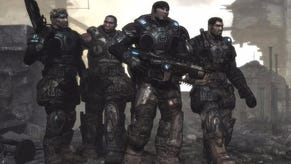Tech Analysis: Gears of War 3 Multiplayer Beta
Hold me closer, shiny Lancer.
With the current generation of HD consoles nowhere near their sell-by date, the recent release of the Gears of War 3 multiplayer beta is noteworthy for several reasons. Not only is this the first opportunity we have had to get hands-on with the game - an event in itself - but it also serves to give us a preview of the kind of technological enhancements we will find as standard in future games using Epic's highly popular Unreal Engine 3 technology.
But let's kick off by saying that this is far from the definitive word on what must surely be the most important Xbox 360 exclusive of the year. Not only does the studio still have months of development time left, but the sample code only covers a significantly cut-down portion of the multiplayer offering. In the single-player campaign, we can expect to see the UE3 rendering tech being tested in significantly more strenuous circumstances, with larger levels, more enemies and of course mammoth bosses to factor into the equation.
That's not to say that this beta isn't content-rich though - with four maps, three gameplay modes and a large array of unlockables, the Gears 3 beta offers many hours of action before all its secrets are revealed, and across the course of this feature you'll find bespoke performance analysis videos for each of the game's quartet of stages, but to cut a long story short, frame-rate is just one a series of improvements that characterises the enhancements made to the core Unreal Engine 3 technology.
As per the vast majority of existing UE3 titles, Gears of War 3 targets a 30FPS update, dropping v-sync if a frame exceeds the 33.33ms rendering time available. However, certainly in these multiplayer maps, performance overall is fairly consistent and screen-tear is only really noticeable in intense fire-fights with plenty of screen-filling explosions. Sustained frame-rate drops can be found, but it takes some seriously intense action to bring these about. The overall impression is of a game that improves upon its predecessor - faster, smoother, more refined - and also this extends to a range of VFX in the rendering pipeline.
Numerous effects and behind-the-scenes tech have received significant upgrades since the last Gears release. Indeed we actually see a significant number of visual elements improved over what was seen in Epic/People Can Fly's recent Bulletstorm.
The most immediately apparent upgrades concern motion blur, lighting and shadowing. As virtually all Unreal Engine 3 titles on console (bar the Mortal Kombat titles) have operated at the 30FPS level, motion blur is essential in giving a smoother look to the visuals. Camera-based motion blur in Gears 3 has been improved significantly over previous iterations, with a much better blending effect utilised.
Also of note is the introduction of a really effective object-based motion blur. OBM has only been used sporadically in previous UE3 titles (such as Mass Effect 2) and even then in a very limited, barely noticeable manner. The quality of the effect seen in Gears 3 is more along the lines of that seen in Killzone 3 and God of War III, and represents a significant leap forward for Unreal Engine 3 - we even see individual levels of motion blur being employed on different parts of the main character's body: if one arm is moving faster than the other, that will be reflected in the amount of blur being applied. This is called "motion blur skinning" by Epic, and according to its own documentation, it is currently only utilised on Xbox 360 and PC, with possible performance implications for this style of implementation if it were added to the PS3 version of UE3.
The overall effect is impressive: the game may well operate on the same baseline frame-rate as its predecessors, but there's little doubt that to the human eye it looks significantly smoother.
Lighting also benefits from extensive upgrades, with outdoor scenes in particular looking more refined and nuanced compared to Gears 2. The god-ray tech we saw introduced in the Xbox 360 and PC versions of Bulletstorm is also in place here, albeit utilised in a much more subtle way, in keeping with the somewhat more restrained art style. It's particularly impressive in the Trenches level, where a sandstorm kicks in, use of alpha reaches insane levels as the effect kicks in and the sun-shafts are showcased in a very pleasing manner.
Use of transparencies in general appears to have been improved as the various smoke and fire effects we see in the beta demonstrate, and Epic enjoys throwing much more in the way of alpha and particles about during gunfire and explosions. The enhanced motion blur effects are also employed with big bangs to emphasise the effect.
Also noticeable is that the relationship between the characters and the environments is much improved - there was something not quite right about this in previous Gears games, a sense that the characters were almost "stuck on" to the scene. What we see in the Gears 3 beta is a greatly improved effect, particularly when the characters move realistically between light and shadow.
Shadows themselves are extremely well realised, remaining very consistent with the lighting and it remains at a decent level of resolution throughout - there are no discernible jumps in quality as you would see with a cascade shadowmap system, and shadows don't just leap out of nowhere.
On top of the effects, the quality of the artwork itself is a marked improvement over what we see in Gears of War 2. The "shiny" detailed look of characters and environments has given way to a more organic look that can work beautifully in concert with the more natural lighting that's been added to this latest iteration of the Unreal Engine.









